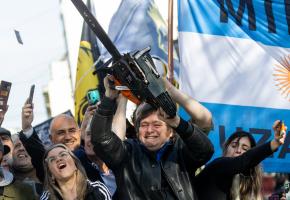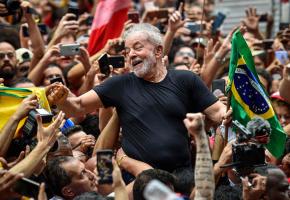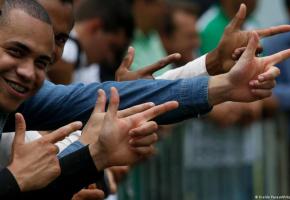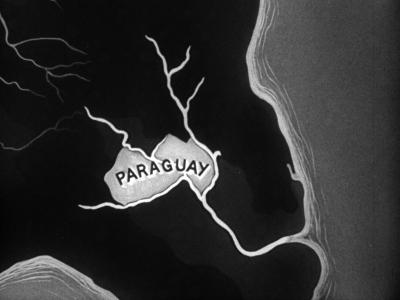Gwen, producer and co-director of the movie, is currently a Wolfson PhD Scholar in Anthropology at University College London (UCL), researching the social history of the Colombian peace process, and she has worked with the Peace Community of San José de Apartadó for five years. She was close to the process of ‘pedagogía para la paz’ (pedagogy for peace) as a member of the network Rodeemos el Diálogo (Let’s embrace dialogue) and was able to attend the FARC’s Tenth and last Conference, where guerrilla members gathered to discuss their expectations of the peace deal and their reintegration.
Nathalia Salamanca-Sarmiento: You've talked about how the documentary shared a ‘message of hope’ to people who believe in peace building ‘against all odds’. What would be that message?
Gwen Burnyeat: My co-director, Pablo Mejía Trujillo, and I wanted to make a film which would not just be about the horrors of war, but about the resourcefulness and creativity of human beings who have suffered unimaginable atrocities, but who despite this manage to build a deep sense and practice of humanity. This is not just something that the Peace Community have; it is something common to many groups of people around Colombia and around the world. Often in the darkest corners you can find the brightest light; survivors are often better at being human than those of us who can only imagine their experiences.
My work with the Peace Community was always guided by a belief that their way of living and seeing the world had something to offer the rest of us – not that we should all go and become rural farming peace communities, but that we could learn from their experiences of community-building, of working together, of economic solidarity practices, of maintaining memory alive, and of a holistic relationship to land and environment. The use of the category of ‘victim’, incredibly over-used in Colombia, has quite often relegated human beings to being passive sufferers of history. In the case of the Peace Community, they use the category ‘victim’ to clamour for justice, for their right to land tenure, and for peace and security measures.
Pablo and I wanted to make a film that showed them not as passive sufferers, but heroic creators of community, producers of chocolate, and builders of peace in the midst of violence. The other reason we thought about hope was the geopolitical context in which we produced the film – the peace process in Colombia and the conversations around it among Colombians from all walks of life. We wanted the film to be a contribution to these multiple discussions, for it to provide a tangible platform from which to think about why there is a peace process, why it is important to stop the violence, and why there are issues on the Havana agenda such as land reform and political participation of opposition parties. In order to contribute to discussions on peace-building, you can’t make a film which shows everything as doomed. That is not a discussion platform, it is a condemnation of history. You have to help people to see that not all is lost – if the Peace Community can do what they’ve done in the midst of so many difficulties, then the rest of us ought to be able to do our part to make Colombia and the rest of the world a better place too, but we cannot do that without knowing historically what is at stake, and the film does not shy away from setting the historical trauma in context either. I think you have to have a balance between hope and history.
Nathalia: What kind of lessons can be drawn from the experience of the Peace Community of San José de Apartadó, when for years it has resisted the presence of armed groups but still gets targeted by them? Even now, in what’s called a ‘post-conflict’ scenario, they keep receiving threats from paramilitary groups.
Gwen: The post-conflict scenario is a discursive promise, which was always going to disappoint. Everyone knew that there would be a spike in violence in the immediate aftermath of the peace agreement, and this was heightened by the conjuncture in which the ‘No’ vote won and a new deal had to be brokered amidst continuing polarisation.
The aspects of the agreement that are supposed to deal with setting in place structures to dismantle these paramilitary, neoparamilitary groups and criminal gangs are not organised yet. It is not surprising, though still tragic, that San José de Apartadó is yet again a focus in this spike in violence and paramilitary regrouping. Until the aspects of the agreement for dismantling these groups are put in place, we cannot begin to measure their success.
In the meantime, it is very troubling to see that there are no interim measures to protect community leaders from threats like these. The strategy of the Peace Community to protect themselves is visibility, which is a double-edged sword. On the one hand, you raise the political cost for actions taken against you when you make yourself more visible as they have. On the other hand, you expose yourself to reprisals. The basis for this strategy is the perceived legitimacy of the visibility practice – in this case, the declaration of neutrality, of not participating in the armed conflict. This legitimacy has been hard-won over twenty years of insisting on it, of repeating this rights-based discourse in everyday encounters with hostile soldiers or guerrillas, of writing to international NGOs and government agencies, and crucially it is supported by one of the widest international support networks that any grassroots organisation could possibly have, including numerous resolutions from the Inter-American Court of Human Rights and the presence of at least three physical accompaniment organisations on the ground. Even so, this legitimacy has not come easily, it has been won at the cost of many lives. So this is a strategy that works, but only because one of the Peace Community’s highest objectives is maintaining their moral stance. In terms purely of protection objectives, it is not sustainable for a nation-wide post-conflict project.
Nathalia: Lastly, and shifting the focus of this short interview to the documentary production, would you share with us what do you think is the importance of communicating academic research through this kind of media?
Gwen: My academic research will be published in a book later this year – Chocolate, Politics and Peace-Building: An Ethnography of the Peace Community of San José de Apartadó, Colombia (Palgrave Macmillan 2017). It is a completely different thing from the film. The book is my own criteria; my own academic analysis of the Peace Community. The film, we wanted to make sure the Community were satisfied with the representation of themselves in it, and we returned to them with a first draft to get their feedback and made some changes on their requests. The film has a more political agenda, perhaps – I wanted it to be useful for peace pedagogy purposes. The book is primarily about contributions to academia. I think that an academic book about this sort of social movement is important and useful – but tends to have a very limited audience, and therefore a very limited impact on the world.
The film has already been seen by thousands of people in Colombia and in Europe – it has been screened in Austria, Poland, Germany, the UK, the Netherlands and Italy. We turned it into an education tool and I toured Colombia doing workshops with it to help people think about the peace process with it during the campaign for the peace referendum, and it won prizes in documentary festivals like MIDBO and Siembra. Anthropology has always been a discipline that has been concerned with how you communicate the knowledge you develop – I think that film is a natural way of communicating academic issues to a non-academic audience in a way that is emotive and can lead to impact in the real world.
Director Gwen Burnyeat will show her film 'Chocolate of Peace' and talk about this inspiring community at La Clave Fest on Saturday 17th June at 1pm. https://www.laclavefest.co.uk/films Free entrance but booking required.
Nathalia Salamanca-Sarmiento is a Colombian human rights researcher. She is currently a PhD candidate in Sociology at the University of Edinburgh,
This interview is an abridged version of the original published on http://www.politicalsettlements.org/2017/02/22/colombians-persistence-i…
Gwen

















